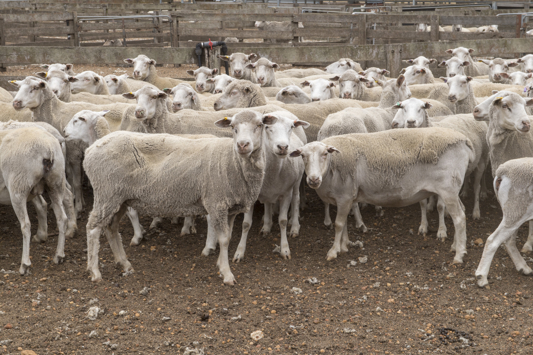The department manages one of only two genetic research flocks in Australia at the Katanning Research Station, funded by MLA as part of its resource flock program.
The current MLA Resource Flock program is a succession to the CRC Information Nucleus Flock and provides an ongoing sheep reference population as well as well-designed and recorded flock information for additional research. It is part of MLA's commitment to the National RD&E plan for sheep.
In 2012 the Sheep Industry approved the establishment of 2 resource flock projects (WA and NSW) to replace the original Information Nucleus Flocks.
The purpose of these two flocks is to underpin both traditional and genomic selection principles managed by Sheep Genetics, especially for hard to measure laboratory traits (or phenotypes) like meat yield, shear force tenderness, and intramuscular fat of lamb meat.
The project has already changed the direction of genetic improvement of lamb towards improved eating quality while further improving production efficiencies.
In addition, the flocks are used for other research projects such as testing the effects of stress on meat phenotypes and for the calibration of carcase and meat quality measurement devices.
Since the introduction of a national breeding evaluation program in Australian in 2000, the rate of genetic improvement in the sheep industry has been good for traits that are easy or cheap to record, but very poor for hard to measure (HTM) traits.
HTM traits are either too expensive to measure, can only be measured late in life or have no clear market signals and include improved eating quality, disease resistance, animal welfare, fertility, methane production and feed intake.
Genomic selection has the potential to change this dynamic, as it allows selection of young animals for both simple and HTM traits. However, prediction of genomic breeding values of selection candidates requires a reference population consisting of animals that have been phenotyped and genotyped.
Reference populations are required for each breed as genomic prediction across breeds is limited in value. To achieve genomic predictions that are moderately accurate, a reference population is required with thousands of animals measured.
Reference populations for HTM traits can be achieved by measuring HTM traits gradually from a few hundred animals from each breed.
A reference population of sheep was initiated by the Sheep CRC Information Nucleus program (2007-2011),
Over 5 years, the Information Nucleus flock gathered a massive database of biological and genetic information by joining 5,000 ewes each year to about 100 industry sires chosen for their genetic diversity.
The sheep were run as 5 sub-flocks, spread over 8 research stations around Australia. One of the largest sites was at DPIRD’s Katanning Research Station in Western Australia. Other sites included Struan and Turrettfield in South Australia, Hamilton and Rutherglen in Victoria and Trangie, Cowra and Armidale in New South Wales.
More data is required to improve prediction accuracy. This can be through a conglomerate of several different sheep flocks, involving different breeds and preferably located across a range of environments, such as in Katanning in the Great Southern region of Western Australia.
At the Katanning Research Station, sheep are DNA tested using a genotyping test to identify which genetic markers a sheep carries, and a wealth of data is recorded both prior to and after slaughter.
The results are used to identify genetic markers associated with production traits on individual sheep and estimate a genomic breeding value for traits that are too difficult or expensive to obtain in other ways.
Developing more accurate genomic breeding values improves accuracy when identifying superior breeding animals for Australia’s future sheep flock at a younger age.
The research has seen significant improvements in the accuracy of Australian Sheep Breeding Values (ASBV) of sires, especially for carcass and meat quality traits that are difficult to measure on live animals.
Process
- Approximately 1,000 ewes are inseminated with semen from about 100 industry sires at each site.
- The lambs are tagged with an electronic identification number at birth and mothered up with its dam. This technology has made it possible to collect much more data faster and more accurately on individual animals.
- All dead lambs are recorded as lamb mortalities, which is a significant point of inefficiency in sheep production systems. Learning why lambs die is an important step in understanding how to address this problem.
- Blood and other tissue samples are collected from each lamb and used to extract DNA.
- A wide range of visual traits such as body conformation and structure are collected at marking, weaning and prior to slaughter.
- Soon after weaning, the lambs are allocated to management groups.
- A wealth of data is recorded on each sheep prior to slaughter. This includes body weight and condition score from birth to slaughter and additional traits such as worm egg counts, scanning for eye muscle and subcutaneous body fat.
- At slaughter, carcass weights are recorded, as well as a range of measurements including various fat depth and eye muscle measurements, meat colour and pH.
- Meat samples are collected and tested for a wide range of meat quality traits that may impact on consumer preferences.
- All data is stored in a central database managed by Sheep Genetics. Information from relatives of the sires that were progeny tested is also used. This data influences the values and accuracy of sheep related to the sire. In this way, rams that contribute semen to the flock have a much wider influence on Australian Sheep Breeding Values (ASBV) than just their own performance.
Other related genetic projects underway at the Katanning Research Station include ‘Adding sustainability traits to the genetic research flock’ and the’Yardstick merino sire evaluation trial’.

